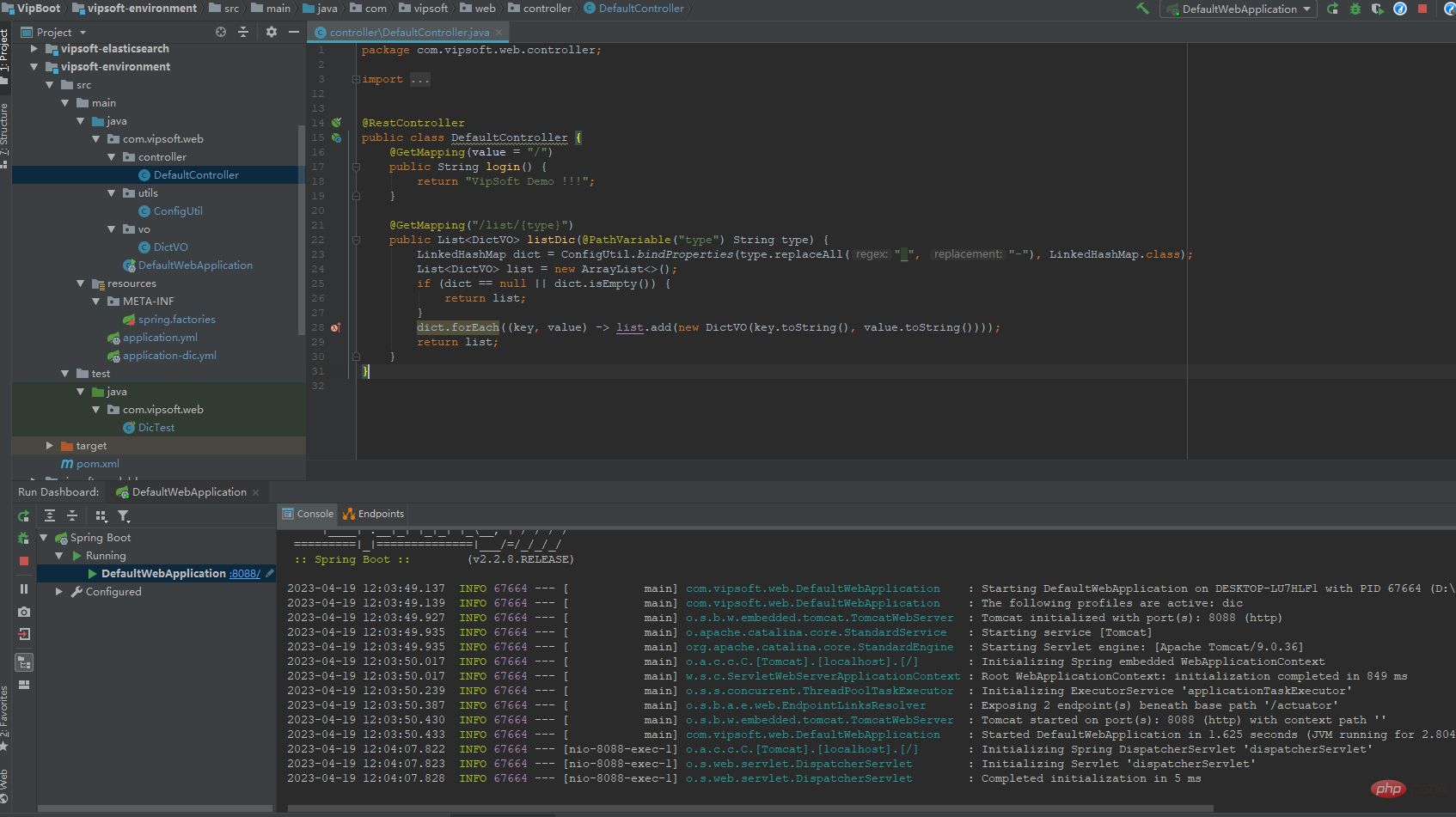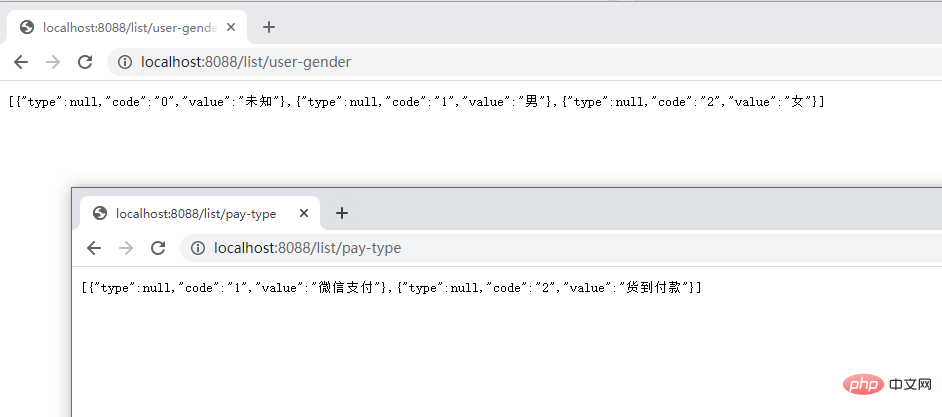Configure the dictionary data in the yml file, and load the data into the Map by loading the yml
The yml configuration in Spring Boot refers to the configuration in other yml. # Create a new application-xxx
in the configuration file directory (such as resources). The yml file must start with application. Multiple files are separated by "," and cannot be newline
Project structure file

application.yml
server:
port: 8088
application:
name: VipSoft Env Demo
spring:
profiles:
include:
dic # 在配置文件目录(如:resources)下新建application-xxx 开头的yml文件, 多个文件用 "," 号分隔,不能换行
#性别字典
user-gender:
0: 未知
1: 男
2: 女application-dic.yml
Change the dictionary Independently into a separate yml file
#支付方式 pay-type: 1: 微信支付 2: 货到付款
In the resources directory, create the META-INF directory and create the spring.factories file,
Spring Factories is a mechanism similar to Java SPI. It configures the implementation class name of the interface in the META-INF/spring.factories file, and then reads these configuration files and instantiates them in the program.
The content is as follows:
# Environment Post Processor org.springframework.boot.env.EnvironmentPostProcessor=com.vipsoft.web.utils.ConfigUtil
ConfigUtil
package com.vipsoft.web.utils;
import org.springframework.boot.SpringApplication;
import org.springframework.boot.context.properties.bind.BindResult;
import org.springframework.boot.context.properties.bind.Binder;
import org.springframework.boot.env.EnvironmentPostProcessor;
import org.springframework.core.env.ConfigurableEnvironment;
import org.springframework.core.env.PropertySource;
import org.springframework.util.Assert;
public class ConfigUtil implements EnvironmentPostProcessor {
private static Binder binder;
private static ConfigurableEnvironment environment;
public static String getString(String key) {
Assert.notNull(environment, "environment 还未初始化!");
return environment.getProperty(key, String.class, "");
}
public static T bindProperties(String prefix, Class clazz) {
Assert.notNull(prefix, "prefix 不能为空");
Assert.notNull(clazz, "class 不能为空");
BindResult result = ConfigUtil.binder.bind(prefix, clazz);
return result.isBound() ? result.get() : null;
}
/**
* 通过 META-INF/spring.factories,触发该方法的执行,进行环境变量的加载
*/
@Override
public void postProcessEnvironment(ConfigurableEnvironment environment, SpringApplication application) {
for (PropertySource propertySource : environment.getPropertySources()) {
if (propertySource.getName().equals("refreshArgs")) {
return;
}
}
ConfigUtil.environment = environment;
ConfigUtil.binder = Binder.get(environment);
}
} DictVo
package com.vipsoft.web.vo;
public class DictVO implements java.io.Serializable {
private static final long serialVersionUID = 379963436836338904L;
/**
* 字典类型
*/
private String type;
/**
* 字典编码
*/
private String code;
/**
* 字典值
*/
private String value;
public DictVO(String code, String value) {
this.code = code;
this.value = value;
}
public String getType() {
return type;
}
public void setType(String type) {
this.type = type;
}
public String getCode() {
return code;
}
public void setCode(String code) {
this.code = code;
}
public String getValue() {
return value;
}
public void setValue(String value) {
this.value = value;
}
}DefaultController
package com.vipsoft.web.controller;
import com.vipsoft.web.utils.ConfigUtil;
import com.vipsoft.web.vo.DictVO;
import org.springframework.web.bind.annotation.GetMapping;
import org.springframework.web.bind.annotation.PathVariable;
import org.springframework.web.bind.annotation.RestController;
import java.util.ArrayList;
import java.util.LinkedHashMap;
import java.util.List;
@RestController
public class DefaultController {
@GetMapping(value = "/")
public String login() {
return "VipSoft Demo !!!";
}
@GetMapping("/list/{type}")
public List listDic(@PathVariable("type") String type) {
LinkedHashMap dict = ConfigUtil.bindProperties(type.replaceAll("_", "-"), LinkedHashMap.class);
List list = new ArrayList<>();
if (dict == null || dict.isEmpty()) {
return list;
}
dict.forEach((key, value) -> list.add(new DictVO(key.toString(), value.toString())));
return list;
}
} Running effect

Unit Test
package com.vipsoft.web;
import com.vipsoft.web.controller.DefaultController;
import com.vipsoft.web.utils.ConfigUtil;
import com.vipsoft.web.vo.DictVO;
import org.junit.jupiter.api.Test;
import org.springframework.beans.factory.annotation.Autowired;
import org.springframework.boot.test.context.SpringBootTest;
import java.util.List;
@SpringBootTest
public class DicTest {
@Autowired
DefaultController defaultController;
@Test
public void DicListTest() throws Exception {
List pay_type = defaultController.listDic("pay-type");
pay_type.forEach(p -> System.out.println(p.getCode() + " => " + p.getValue()));
List user_gender = defaultController.listDic("user-gender");
user_gender.forEach(p -> System.out.println(p.getCode() + " => " + p.getValue()));
}
@Test
public void getString() throws Exception {
String includeYml = ConfigUtil.getString("spring.profiles.include");
System.out.println("application 引用了配置文件 =》 " + includeYml);
}
} 
The above is the detailed content of How does SpringBoot load dictionary data in yml files?. For more information, please follow other related articles on the PHP Chinese website!